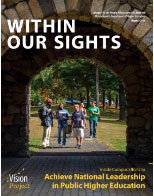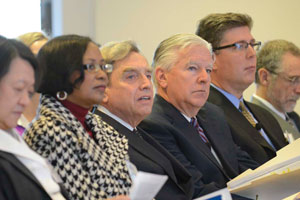Vision Project is Having Impact, Higher Ed Commissioner Tells Understanding Boston Forum Audience
November 5, 2013
 The state’s community colleges, colleges and universities are all making progress toward the goal of producing the best-educated citizenry and workforce in the nation, the state’s higher education commissioner said at an Understanding Boston Forum at the Boston Foundation today.
The state’s community colleges, colleges and universities are all making progress toward the goal of producing the best-educated citizenry and workforce in the nation, the state’s higher education commissioner said at an Understanding Boston Forum at the Boston Foundation today.
“The challenge is scaling the best practices,” Commissioner Richard M. Freeland said as he publicly unveiled the second annual report on progress toward the state’s Vision Project goals. The project is a strategic plan adopted by the state in 2010 to achieve national leadership in public higher education by innovating and tracking progress in six key areas, including workforce alignment, student learning and closing the achievement gap between whites and students of color.
 While noting that this year’s funding for the state’s public colleges and universities was “the best budget public Higher Ed has had in my lifetime,” Freeland warned of the constant tension between “maintaining affordability and investing in quality.” The Vision Project, he said, “is the way forward to recognize that there is a new reality in Massachusetts and excellence in public education is our future.”
While noting that this year’s funding for the state’s public colleges and universities was “the best budget public Higher Ed has had in my lifetime,” Freeland warned of the constant tension between “maintaining affordability and investing in quality.” The Vision Project, he said, “is the way forward to recognize that there is a new reality in Massachusetts and excellence in public education is our future.”
The Boston Foundation has been a supporter from the beginning, said President and CEO Paul S. Grogan. “Education is at the top of our list of priorities and will continue to be,” he said. “The workforce of Massachusetts, the leadership of Massachusetts, is going to come from our public institutions, so they must be the most high-performing institutions they can be.”
During a panel discussion, three leaders of public institutions talked about innovations taking place on their campuses as well as the challenges ahead. Marty Meehan, Chancellor of the University of Massachusetts Lowell, discussed interventions his campus put in place to increase the retention rate for freshmen, which had been 75 percent and is now at 84 percent and climbing. “This is not an easy thing to do, but once you start doing it, graduation rates go up,” he noted.
 Barry M. Maloney, President of Worcester State University, discussed the importance of extra state funding for internships, “which has allowed more of our students to get out into the workforce in a paraprofessional way.” Enriching and expanding internship opportunities will be critical, he said.
Barry M. Maloney, President of Worcester State University, discussed the importance of extra state funding for internships, “which has allowed more of our students to get out into the workforce in a paraprofessional way.” Enriching and expanding internship opportunities will be critical, he said.
Ira H. Rubenzahl, President of Springfield Technical Community College, noted the need to reform developmental education (remedial) classes and to overhaul the math curriculum so that it is better suited for students who don’t intend to be engineers or scientists. He also highlighted a program that trains students to operate sophisticated machines in high-tech manufacturing settings—jobs that pay around $50,000 a year. The community college partnered with local companies and the regional employment board to publicize the program, which is now full.
 All three leaders discussed the importance of robust state funding for higher education and its impact on affordability for students. “Our tuition and fees at community colleges are the fourth-highest in the nation,” said President Rubenzahl. “The number of students taking out loans in the past four years has jumped from 8 percent to 24 percent.”
All three leaders discussed the importance of robust state funding for higher education and its impact on affordability for students. “Our tuition and fees at community colleges are the fourth-highest in the nation,” said President Rubenzahl. “The number of students taking out loans in the past four years has jumped from 8 percent to 24 percent.”
Chancellor Meehan noted that even if last year’s funding level is maintained, the system would still only be getting the resources it received during the Romney administration (2003-07).
“The Vision Project is providing an envelope for a revolutionary process that could vault us into national leadership in public higher education,” said Mr. Grogan in closing remarks. “A case has been made here that is very powerful about what is at stake—and what’s encouraging is that the case is being embraced by people outside of higher education as well.”
